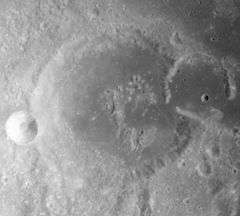Gutenberg (crater)
|
Apollo 16 image | |
| Coordinates | 8°36′S 41°12′E / 8.6°S 41.2°ECoordinates: 8°36′S 41°12′E / 8.6°S 41.2°E |
|---|---|
| Diameter | 74 km |
| Depth | 2.3 km |
| Colongitude | 318° at sunrise |
| Eponym | Johann Gutenberg |
Gutenberg is a lunar crater that lies along the west edge of Mare Fecunditatis, in the eastern part of the visible Moon. it is currently named after Johass Gutenberg To the southeast is the crater Goclenius, and to the southeast are Magelhaens and Colombo. To the west-southwest is the crater Gaudibert, across the Montes Pyrenaeus that run south from Gutenberg.
The rim of Gutenberg is worn and eroded, most notably in the east where it is broken by the overlapping crater Gutenberg E. This crater in turn has gaps in its southeast and southwest rims, forming a passage to the lunar mare to the east. There are also clefts and valleys in the southern rim where it joins Gutenberg C. The crater Gutenberg A intrudes into the southwest rim.
The floors of Gutenberg and Gutenberg E have been flooded in the past by lava, forming a relatively flat plain across the bottom. This surface is broken across the northeast by a pair of clefts that form a part of the Rimae Goclenius. These extend northwest from the Goclenius region. The central rise of Gutenberg is a semi-circular range of hills that are the most prominent in the south, and the concave part lies open to the east. The floor is otherwise not marred by any significant craters.
Satellite craters
By convention these features are identified on lunar maps by placing the letter on the side of the crater midpoint that is closest to Gutenberg.
| Gutenberg | Latitude | Longitude | Diameter |
|---|---|---|---|
| A | 9.0° S | 39.9° E | 15 km |
| B | 9.1° S | 38.3° E | 15 km |
| C | 10.0° S | 41.1° E | 45 km |
| D | 10.9° S | 42.8° E | 20 km |
| E | 8.2° S | 42.4° E | 28 km |
| F | 10.2° S | 42.6° E | 8 km |
| G | 6.0° S | 40.0° E | 32 km |
| H | 6.7° S | 39.0° E | 5 km |
| K | 7.2° S | 40.8° E | 6 km |
External Links
- Lunar Photo of the Day, "Land of Manna", October 5, 2006, showing Gutenberg and vicinity
References
- Andersson, L. E.; Whitaker, E. A. (1982). NASA Catalogue of Lunar Nomenclature. NASA RP-1097.
- Blue, Jennifer (July 25, 2007). "Gazetteer of Planetary Nomenclature". USGS. Retrieved 2007-08-05.
- Bussey, B.; Spudis, P. (2004). The Clementine Atlas of the Moon. New York: Cambridge University Press. ISBN 978-0-521-81528-4.
- Cocks, Elijah E.; Cocks, Josiah C. (1995). Who's Who on the Moon: A Biographical Dictionary of Lunar Nomenclature. Tudor Publishers. ISBN 978-0-936389-27-1.
- McDowell, Jonathan (July 15, 2007). "Lunar Nomenclature". Jonathan's Space Report. Retrieved 2007-10-24.
- Menzel, D. H.; Minnaert, M.; Levin, B.; Dollfus, A.; Bell, B. (1971). "Report on Lunar Nomenclature by the Working Group of Commission 17 of the IAU". Space Science Reviews. 12 (2): 136–186. Bibcode:1971SSRv...12..136M. doi:10.1007/BF00171763.
- Moore, Patrick (2001). On the Moon. Sterling Publishing Co. ISBN 978-0-304-35469-6.
- Price, Fred W. (1988). The Moon Observer's Handbook. Cambridge University Press. ISBN 978-0-521-33500-3.
- Rükl, Antonín (1990). Atlas of the Moon. Kalmbach Books. ISBN 978-0-913135-17-4.
- Webb, Rev. T. W. (1962). Celestial Objects for Common Telescopes (6th revised ed.). Dover. ISBN 978-0-486-20917-3.
- Whitaker, Ewen A. (1999). Mapping and Naming the Moon. Cambridge University Press. ISBN 978-0-521-62248-6.
- Wlasuk, Peter T. (2000). Observing the Moon. Springer. ISBN 978-1-85233-193-1.
